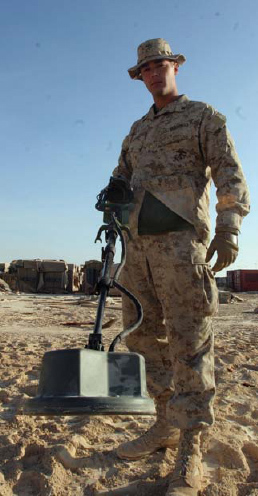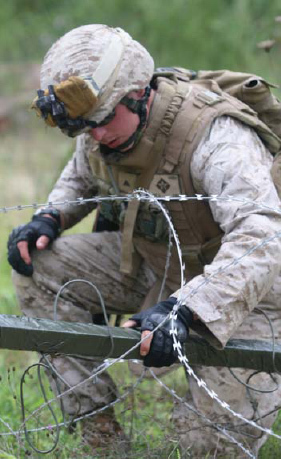Deny enemy movement
In densely covered country, such as forest or jungle, the enemy may avoid tracks and use a different route every day to move men and supplies – thus making ambush difficult and expensive in terms of manpower. One solution is to spread landmines across the area using special artillery shells or by dropping them from aircraft. These particular mines are designed to be difficult to see in the dense foliage and to self-arm when they hit the ground. In dense cover they are difficult to avoid. This practice, of course, is highly unlawful besides being ethically questionable.
CLEARING MINES IN CONVENTIONAL WARFARE
As you will now understand, there are two concerns relating to clearing a minefield in a conventional conflict. The first is that you have to find and neutralize the mines. The second is that you have to stay alive while the covering fire is trying to kill you. To get around these two issues there have been a load of techniques developed. Some are much cleverer than others.

Mine clearance: the loneliest job in the world. (USMC)
Avoiding the enemy fire
Given that clearing mines manually is slow and requires concentration it is probably as well that the enemy are not shooting at you while you are trying to do it. Even with most of the gadgets listed below people are exposed to fire. And of course, you don’t want to lose your shiny new armoured bulldozer to an anti-tank shell do you? How do you avoid all this distraction? Put simply, there are two ways to stop people shooting at your mine-clearing team. You can either make them keep their heads down by bringing heavy fire to bear from artillery or small arms or you can lay down smoke to spoil their view. If you do use smoke, remember that defensive mortars, artillery and machine guns are likely to be set up on fixed fire patterns to cover the minefield without being able to see it.
Defeating landmines
There are several ways of defeating a defensive screen of landmines and clearly some are better than others from the point of view of not getting you killed while you are doing it or later when you find the mines which were missed – the hard way. Here we will take a look at the pros and cons of the most popular methods.
Electronic mine detectors
These gadgets are rather like metal detectors to look at and indeed they work in a similar fashion. Metal in the construction of a mine is picked up in the electromagnetic field generated by the machine and registers with a ‘ping’ or a twitch of the dial.
There are two things to think about here: these mine detectors only pick up mines which have metal in them so they will only find some mines as modern mines are not metallic and are designed not to be found. And think about it, if you had a box of old mines with metal bits in them wouldn’t you scatter nails or something around?
There is research into mine detection equipment which finds mines even when they do not contain metal. I don’t want to give too much away here just in case it helps our enemies but I understand scattering bits of plastic around is not enough to defeat these machines. The words thermal neutron backscatter imaging (TNBI) spring to mind as one such avenue of exploration. This technique measures the way the molecules in a substance vibrate and therefore can be used to identify certain specific materials. One argument against this is the idea of planting plastic chips as distraction but the TNBI can be tuned to pick up only a specific explosive or constituent thereof.
In the words of one ‘techie’ who is working on this: ‘We describe an experimental and theoretical project centred on the use of nonlinear acoustic shock impulses and micro-electromechanical systems (MEMS) sensors to detect and image buried, regular-shaped inclusions at various depths in soil. The use of shock waves is partly motivated by the perceived limited capability of conventional acoustic delivery modes, and by recent research which shows that shock impulses travel efficiently in granular media.’ Don’t you just love having smart guys on our side? This geek-speak relates to a type of underground sonar but we don’t have to worry about it until we get issued with the new kit.
Pointed-stick mine detectors
Using a pointed stick or bayonet to probe in the dirt for a mine buried just under the surface will find every mine in a minefield because if the operator doesn’t find it with the stick they will find it with their knees a short time later. This technique sharpens the concentration greatly and is surprisingly effective.
The stick technique is very slow as you may imagine. Every inch of ground has to be pored over to avoid missing one. It is no use under fire for obvious reasons but it is ideal for clearing areas sowed with mines by terrorists when you have the leisure time. Or someone has.
Artillery fire
Concentrated high explosive shell fire will detonate a patch of mines. But it does take a thoroughly good ‘stonking’ to get most of them. I wouldn’t want to go over the ground first.
Bangalore Torpedoes
Captain McClintock, of the British Indian Army unit the Madras Sappers and Miners invented the Bangalore Torpedo at Bangalore, India, in 1912 and it first became widely used in World War I. It continued in use through World War II and up to the present day in Afghanistan where it is used for clearing booby-trapped areas. The latest model torpedo is manufactured by Mondial Defence Systems of Poole, UK, for the UK and US armed forces
There are various designs but the idea is a sort of long stiff charge which is pushed across the target area from behind. When it is detonated it clears a path through. They are quite effective for clearing barbed wire, minefields and other booby traps. The range of effective operation is a strip about a metre wide and 15m long so a minefield may take several goes with some heroic Sapper following up each effort with a new torpedo. The shop-bought torpedo comes in sections with threaded ends each about 5ft long and these are screwed together from the safety of, say, a trench, and pushed ahead of the user towards the enemy.
British Royal Engineers and American Combat Engineers have also been known to construct versions of the Bangalore in the field by assembling segments of metal picket posts and filling the concave portion with Plastic Explosive (PE). The PE is then primed with detonating cord and a detonator and the pickets are then taped or wired together end-to-end to make a long torpedo, producing shrapnel that cuts wire and/or detonates a strip of mines. This method produces results similar to the standard-issue Bangalore, and can be assembled to the desired length by adding picket segments.

Improvized Bangalore Torpedo is placed amongst concertina wire during demolitions training prior to combat deployment in 2009. (USMC)
The newest evolution of the Bangalore is the Bangalore Blade, made from lightweight aluminium and using explosively formed penetrator technology to breach obstacles which the original Bangalore would have been unable to defeat. In a test detonation conducted on the television show Future Weapons, the Bangalore Blade blasted a gap roughly 5m wide in concertina wire, and created a trench deep enough to detonate most nearby AP mines. The Bangalore Blade was developed in the UK by Alford Technologies and is intended for use with both standard army and SF units that require a lightweight, portable obstacle-clearing device. You will understand the benefit of a wider gap now won’t you?
Armoured mine ploughs
These are usually restricted to Armoured units or Engineers but a pair of large, angled ‘Dozer’ blades on the front of a tracked vehicle is perfectly effective against anti-personnel mines and pretty good against anti-tank mines too.